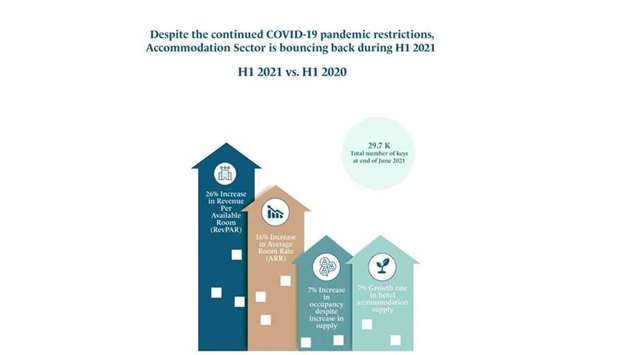Domestic tourism played a key role in boosting Qatar’s hospitality sector amid the coronavirus (Covid-19) pandemic situation, registering a 7% increase in hotel accommodation supply between the first half (H1) of 2020 and H1 2021, a mid-year performance report of Qatar’s tourism and hospitality sectors has shown.
The report covering the January-June 2021 period noted that average room rates (ARR) increased by 16%, and revenue per available room (RevPAR) increased by 24%, all outpacing 2020 monthly averages.
Properties that have been utilised as quarantine/Covid-19 response facilities have been removed from the full market data set from March 2020 to date.
“The upswings in Qatar’s accommodation sector can primarily be attributed to an increase in domestic tourism,” Qatar Tourism said in a statement yesterday.
It is learnt that many residents, especially families, have opted for local “staycations” at hotels and resorts, as well as dining in several restaurants, in the country instead of travelling overseas in H1 2021, giving a fillip to these sectors.
The 7% overall increase in hotel accommodation supply between H1 2020 and H1 2021, the report said, was mainly driven by additional hotel apartment and five-star hotel keys in operation across Qatar.
The total number of keys at the end of Q2 2021 amounted to 29,688 keys, compared to 27,829 keys in the same period in 2020, it added.
The report noted that the lifting of the blockade and opening the borders to GCC nationals in January 2021 also helped to boost the number of arrivals from neighbouring countries to Qatar, witnessing a 9% increase in Saudi visitors and 100% increase in Emirati visitors.
Qatar Tourism cited the high vaccination rates and issuance of approvals for hosting and organising events and necessary business activity as factors that will support the gradual recovery of Qatar’s tourism and affiliated sub-sectors such as aviation, hospitality, entertainment, and retail.
“Qatar’s government is keen to provide safe and enjoyable travel experiences for international visitors and is taking all necessary precautions to ensure visitors have a safe experience,” Qatar Tourism said.
While the number of international visitors in the first six months of 2021 remained low due to the pandemic, the report said it is seeing a return of “business and leisure visitations” with the partial reopening of Qatar’s borders in July this year.
As such, it also expects hotel occupancy to improve further with more foreign visitors arrivals.
“International visitation decreased by 82% in H1 2021 as compared to H1 2020. This decline is largely due to very strong visitor arrivals figures for January and February 2020, just prior to border closures in March 2020,” the report noted.
However, the report stressed that “despite the negative impacts of the pandemic, Qatar’s hospitality sector fared exceptionally well compared to global benchmarks”.
“Doha had the 6th highest occupancy rate worldwide and the smallest RevPAR decline, by far, among all key cities in 2020,” it added.
The report is available at https://www.qatartourism.com/en/news-and-media/sector-statistics/tourism-reports.
Properties that have been utilised as quarantine/Covid-19 response facilities have been removed from the full market data set from March 2020 to date.
“The upswings in Qatar’s accommodation sector can primarily be attributed to an increase in domestic tourism,” Qatar Tourism said in a statement yesterday.
It is learnt that many residents, especially families, have opted for local “staycations” at hotels and resorts, as well as dining in several restaurants, in the country instead of travelling overseas in H1 2021, giving a fillip to these sectors.
The 7% overall increase in hotel accommodation supply between H1 2020 and H1 2021, the report said, was mainly driven by additional hotel apartment and five-star hotel keys in operation across Qatar.
The total number of keys at the end of Q2 2021 amounted to 29,688 keys, compared to 27,829 keys in the same period in 2020, it added.
The report noted that the lifting of the blockade and opening the borders to GCC nationals in January 2021 also helped to boost the number of arrivals from neighbouring countries to Qatar, witnessing a 9% increase in Saudi visitors and 100% increase in Emirati visitors.
Qatar Tourism cited the high vaccination rates and issuance of approvals for hosting and organising events and necessary business activity as factors that will support the gradual recovery of Qatar’s tourism and affiliated sub-sectors such as aviation, hospitality, entertainment, and retail.
“Qatar’s government is keen to provide safe and enjoyable travel experiences for international visitors and is taking all necessary precautions to ensure visitors have a safe experience,” Qatar Tourism said.
While the number of international visitors in the first six months of 2021 remained low due to the pandemic, the report said it is seeing a return of “business and leisure visitations” with the partial reopening of Qatar’s borders in July this year.
As such, it also expects hotel occupancy to improve further with more foreign visitors arrivals.
“International visitation decreased by 82% in H1 2021 as compared to H1 2020. This decline is largely due to very strong visitor arrivals figures for January and February 2020, just prior to border closures in March 2020,” the report noted.
However, the report stressed that “despite the negative impacts of the pandemic, Qatar’s hospitality sector fared exceptionally well compared to global benchmarks”.
“Doha had the 6th highest occupancy rate worldwide and the smallest RevPAR decline, by far, among all key cities in 2020,” it added.
The report is available at https://www.qatartourism.com/en/news-and-media/sector-statistics/tourism-reports.




